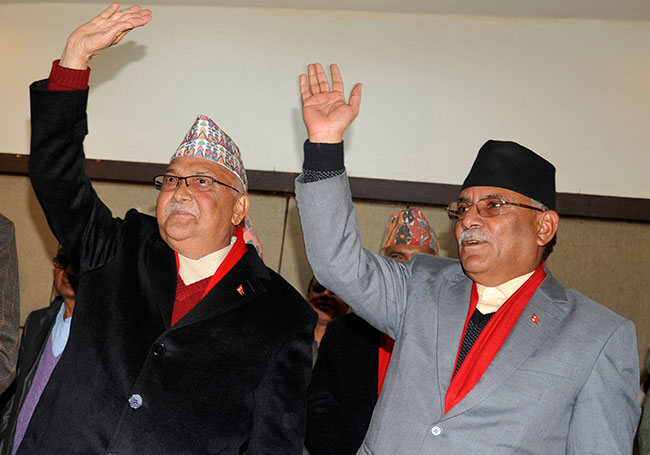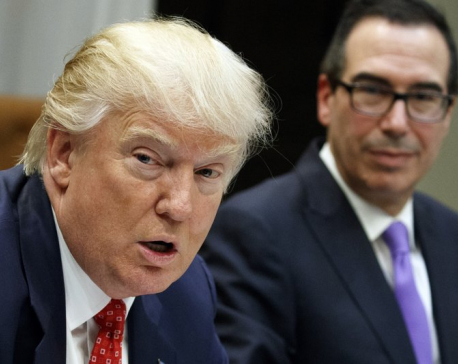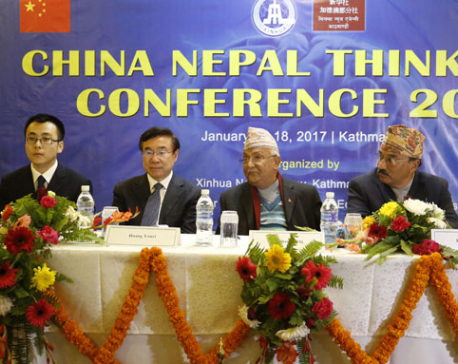
OR

Pramod Jaiswal
The author is a Senior Fellow at the Institute of Peace and Conflict Studies in New Delhi and Pangoal Institution in Beijingnews@myrepublica.com
More from Author
Hill voters accused Congress of not speaking strongly against the blockade while Madhesis were disenchanted with its inadequate support for statute amendment
The Left Alliance has secured what has been a thumping victory in the provincial and federal elections of Nepal. While the Madhesi parties also bagged a respectable share, the party leading the government, Nepali Congress (NC), faced a major setback. What would be the permutation and combination in new government formation? What does the result mean for India and China? Will Nepal now be stable with the rise of the left, as its proponents promised, or will the game of musical chairs continue? These are among the most pertinent questions in Nepal at the moment.
The Left Alliance that comprises two major left parties—CPN-UML and CPN (Maoist Center)—secured more than two-third of the seats under the FPTP component and they are also sure to get over half of the total PR seats. Though Congress will emerge as the second largest party, it will lag far behind the Left Alliance. Unfortunately, most of the prominent Congress leaders lost in the elections. Interestingly, in spite of the thumping victory of the Left Alliance, UML alone could not get simple majority to form government. Hence a coalition government is inevitable. Moreover, even if there is to be a merger between the two left parties, the Left Alliance will still fail to garner two-third support, which would mean it cannot fiddle with the constitution through amendments. Thus there are enough checks and balances.
There are numerous factors that led to the rise of the left, their agenda of development and political stability being the most appealing among them. In past ten years, Nepal has had ten prime ministers. But no prime minister could hold office for more than two years. Political instability in turn hurt economic development of Nepal. In order to convince voters, the Left Alliance came up with a common manifesto and announced a possible merger of the two parties after the elections.

Milking nationalism
The ‘nationalist’ image of KP Sharma Oli among the hill voters was another factor. Many admired him for standing strong against India during the time of the ‘unofficial blockade’. Similarly, there was precise calculation in candidate allocation and election management by left parties. The top leaders of the alliance conducted rigorous election campaigns throughout the country in spite of their poor health and personal tragedies. On the other hand, Nepali Congress lacked both leadership and clear election agenda.
Moreover, Congress failed to form a strong alliance of its own to counter the Left Alliance. Rather, the incumbent prime minister and chairman of NC, Sher Bahadur Deuba, became mired in several controversies, which made him quite unpopular. Similarly, Congress’s duality during the ‘unofficial blockade’ failed to impress both hill and Madhesi voters. While hill voters accused them of not speaking strongly enough against the Indian role in the blockade, the Madhesis were disenchanted as they felt Congress was not supporting their demand for constitution amendment.
With the mandate in favor of the Left Alliance, there are speculations that Oli, the chairman of UML, would lead the next government. If he does, Oli will have two major challenges during his tenure: one internal and one external. At the domestic level, the challenge is addressing the demands of Madhesi and other marginalized groups through constitutional amendment. The external challenge would be taking the southern neighbor into confidence. Oli needs to adeptly deal with both these challenges if there is to be political stability in Nepal.
As per their understanding before the elections, the Maoists would claim 40 percent share in the central government, provincial governments and the unified party. Similarly, Maoist chairman Pushpa Kamal Dahal would hold the chair of the combined party. However, there are doubts that UML would easily give away such a huge leverage to the Maoists. Nonetheless, If Dahal succeeds in doing so, he would emerge as the unchallenged leader and exercise tremendous power.
Though Dahal has time and again stated the possibility of merger, it was never reiterated by Oli. This clearly indicates that merger would not be an easy task.
The geopolitical complex
If the Left Alliance fails to manage power-sharing, Dahal also has the option of forming government with the support of Nepali Congress. He would have enough seats to form government with the support of Congress and Madhes based parties. India would feel more comfortable working with Dahal than Oli. Hence Dahal government would have strong Indian support. Hence he would not have any external challenge; on the other hand, a strong opposition would create instability and jeopardize the daily function of his government. Thus, whether Oli or Prachanda leads the government, they will have challenging days ahead.
India occupies a predominant position in Nepal and it has played an important role in all the political changes of Nepal. Traditionally, China has refrained from interfering with Nepal’s internal affairs. However, there were media reports of China backing the Left Alliance. China’s assertiveness has increased with the rise in power of Xi Jinping. Since the introduction of the ambitious Belt and Road Initiative (BRI), it has further enhanced its engagement in South Asia, including in Nepal. Nepal and China signed an MoU on BRI this year, while India boycotted the BRI event. In such a circumstance, the competition for influence in Nepal between the two neighbors is obvious.
Under BRI projects, China wants to enhance connectivity with Nepal through roads and railways. It has shown interest in Nepal’s hydro-power and airport projects. Chinese experts claim that if there is left government in power, the Chinese president would pay a visit to Nepal in a few months. President Xi will then announce several development projects including railway connectivity between China and Nepal. With favorable government in power, the two countries would also sign numerous deals to enhance bilateral relations.
However, the deepening engagement with China would also invite Indian anxiety and concerns. Hence, while inviting Chinese development projects, Nepal should assure India that its vital strategic interests are taken care of. Balancing the two neighbors has always been a major challenge for Nepal. Let us hope the new government is able to meet this challenge and provide the much-needed stability and development.
The author is a Senior Fellow at the Institute of Peace and Conflict Studies in New Delhi and Pangoal Institution in Beijing
You May Like This

Failure on health bill also hurts prospects for tax overhaul
WASHINGTON (AP) — House Republicans' failure to repeal Barack Obama's health care law deals a serious blow to another big... Read More...

Prospects and challenges
While implementing ‘One Belt One Road,’ emerging global power will face obstacles from the current global power ... Read More...

Prospects of participation
As a football fan and occasional drinker, my conversations and banter with my friends tends to centre on the clubs... Read More...







Just In
- NRB to provide collateral-free loans to foreign employment seekers
- NEB to publish Grade 12 results next week
- Body handover begins; Relatives remain dissatisfied with insurance, compensation amount
- NC defers its plan to join Koshi govt
- NRB to review microfinance loan interest rate
- 134 dead in floods and landslides since onset of monsoon this year
- Mahakali Irrigation Project sees only 22 percent physical progress in 18 years
- Singapore now holds world's most powerful passport; Nepal stays at 98th











Leave A Comment